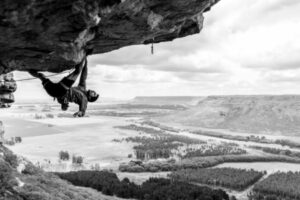Rock climbing is a great way to get in shape and have fun outdoors. It can be a challenging sport, but it’s also very rewarding. If you’re new to rock climbing, don’t worry — we’ll teach you everything you need to get started! We’ll cover the basics, including how strong you have to be, the gear you’ll need, and how to find good places to climb.
Fitness Level Needed for Rock Climbing

Although it’s not true you have to be incredibly fit to rock climb, it is true that you have to be somewhat in shape. And once you can actually start rock climbing, it can be a workout in and of itself! It’s the perfect way to exercise while enjoying the amazing experience of climbing outdoors (and indoors).
Stamina is going to be very important as is upper body strength. However, lower body strength is also very crucial for balance and additional power. You’ll be using your entire body, including your arms (especially your shoulders and forearms), legs, back, glutes, and core. Being flexible is helpful, too, as you’ll be reaching and stretching your body going from one handhold to the next.
There are also a variety of different styles of rock climbing. These include bouldering, lead climbing, sport climbing, trad climbing, and alpine climbing. Each style has different requirements in terms of fitness and equipment. Make sure you research before you start to ensure you’re properly prepared ahead of time.
And if you’re not quite in shape enough to start rock climbing yet, we recommend full-body workouts a few times a week. Try to mix in some cardio (running and biking) with strength training. Work on all the major muscle groups, and spend a little extra time working on your “pull” muscles like that lats in your back, and always remember to stretch!
Gear Needed for Rock Climbing

Luckily, rock climbing isn’t too expensive of a sport, but you still shouldn’t buy everything you could possibly need on day 1. You can usually rent gear from a local climbing gym or outdoor shop, especially if it won’t be a regular event for you. Better yet, go with a guide or group so you have experts to show you how to use the gear correctly. This is not an area to be guessing in.
When you’re climbing more frequently, you can start buying your own gear.
Gear you’ll need includes:
- Shoes
- Helmet
- Chalk
- Chalk bag
- Chalk brush
- Harness
- Rope
- Carabiners
- Belay device
- Crash pad (optional in some cases)
You can expect to pay at least $500 for all the necessary equipment plus a few hundred more if you want your own crash pad.
If you want to simply indoor climb, you can head to the local climbing gym where they might lend you everything you need for the session. The price of sessions can vary, but on the low end they cost $10-15. Not all climbing gyms offer rentals, so be sure to check before you visit.
What Should You Look for in Climbing Gear?

Whether you’re renting or purchasing your own equipment, never compromise on quality. Climbing with cheap or old gear can be dangerous, but it can also make rock climbing harder. Higher quality gear will last you a lot longer and can make climbing more enjoyable. We cannot stress it enough that you can’t just put on any piece of old running shoes and hit the rock wall. You might not get any grip, and your shoes will likely start tearing quickly.
Climbing Shoes
Of course, climbing shoes are one of the most important pieces of gear, so don’t scrimp on them! They should be snug but comfortable and have rubber soles for a super strong grip. Good rock climbing shoes can cost around $150, but they’re definitely worth the investment.
Rope and Harness
As for the rope, you’ll need to get a dynamic rock climbing rope, which is designed to hold heavy weight while being stretchy. They’re some of the most versatile, strong, and commonly used ropes, and you can get a good one for around $150. These are quite expensive, but they’re mandatory!
The harness needs to be comfortable, secure, and adjustable. They tend to cost around $50.
Helmet
A helmet is also a must for any type of climbing as it’ll protect you from falling rocks or debris. A good helmet will have ventilation to keep you cool and comfortable, as well as a solid and customizable fit. You can find these for about $100.
Belay Device and Carabiners
The belay device is what you use to control the rope while someone else is climbing. This is a must-have piece of safety equipment, and it’ll cost you about $35.
Carabiners are also essential for clipping the rope into the harness and belay device. You can get a bundle of carabiners for around $10-15, which is pretty cheap. Always go for the heavy duty carabiners.
Crash Pad
A crash pad will help cushion your fall and work to prevent any injuries. They tend to cost around $200 — while it may seem expensive, it’s a worthwile investment, especially if you’re planning on doing a lot of bouldering.
Chalk and Accessories
Finally, you’ll want to get yourself some chalk to keep your hands dry. It makes it so much easier to hold your grip. You can get a big bag of chalk for around $10, which will last you quite a while. You should also get a chalk brush and chalk bag while you’re at it, which will help you keep your hands clean and allow you to dip into your chalk mid-climb. These inexpensive items will cost you around $30-40 total.
And More
And, of course, when you’re heading to the outdoors, you should always bring plenty of water and snacks. When you’re rock climbing, you’re going to be using up a lot of energy.
It’s also a good idea to carry a first-aid kit, just in case you or anyone else gets injured.
How to Find Places to Climb

As a beginner, you must never free solo climb. This is when you climb without any safety gear or spotter. It is extremely dangerous and not worth the risk, no matter how tempting it might be. Instead, you should either boulder or rope climb with a partner. Bouldering is when you climb without a rope, and it’s a great way to get started. Rope climbing is when you use a rope and belay device to climb, and it’s perfect for beginners. Either can be done at local gyms or climbing areas.
Local Gym and Clubs
To find places to climb, start by checking out your local gym. This is the ideal place because you can likely rent gear, take classes, and meet other climbers. Staff members can also give you invaluable tips and advice, especially when you’re just getting started. Once you feel comfortable, you can start exploring outdoor options if that is something that interests you.
Climbing Clubs
You can also find climbing clubs, places that are a bit like gyms but only focus on climbing. These clubs often have some seriously good walls of 50 feet or more that offer dozens of potential routes, along with bouldering. Forums are a great place, too, to meet local climbers.
Outdoor Shops
In many areas, outdoor shops offer a climbing wall or a bouldering cave. These are often free, and while the shop of course would like you to buy gear from them, the amenities are usually offered just to get more people in to climbing. Wherever you get your backpacking tents and paddling gear, ask if they have a section devoted to climbing and potentially a place to practice.
Outside
The amazing part about rock climbing is that you can do it practically anywhere. With so many options to choose from, you can realistically climb all year round. Of course, you’ll need to do some research if you plan on climbing outside. Remember that outdoor climbing is less controlled, and there are more variables to consider. If you plan to do so, make sure you’re properly prepared before heading out (especially for the weather), and always climb with an experienced partner.
Outdoor climbing spots are usually located in parks or nature reserves. You can find these by searching online or asking around at your local climbing gym. Once you’ve found a spot, double check the weather and regulations before climbing. Some places may require a permit and others may be off-limits to climbers.
Just before you climb, inspect the area for any loose rocks or dangerous conditions, avoiding any spot that looks unsafe. Since you’re just starting out, you’ll need your experienced partner to teach you the ropes, literally. Get a feel for belaying before trying it on your own. Understanding how it works and the proper safety procedures is essential.
With the right gear and a little bit of practice, you’ll be rock climbing like a pro in no time.







